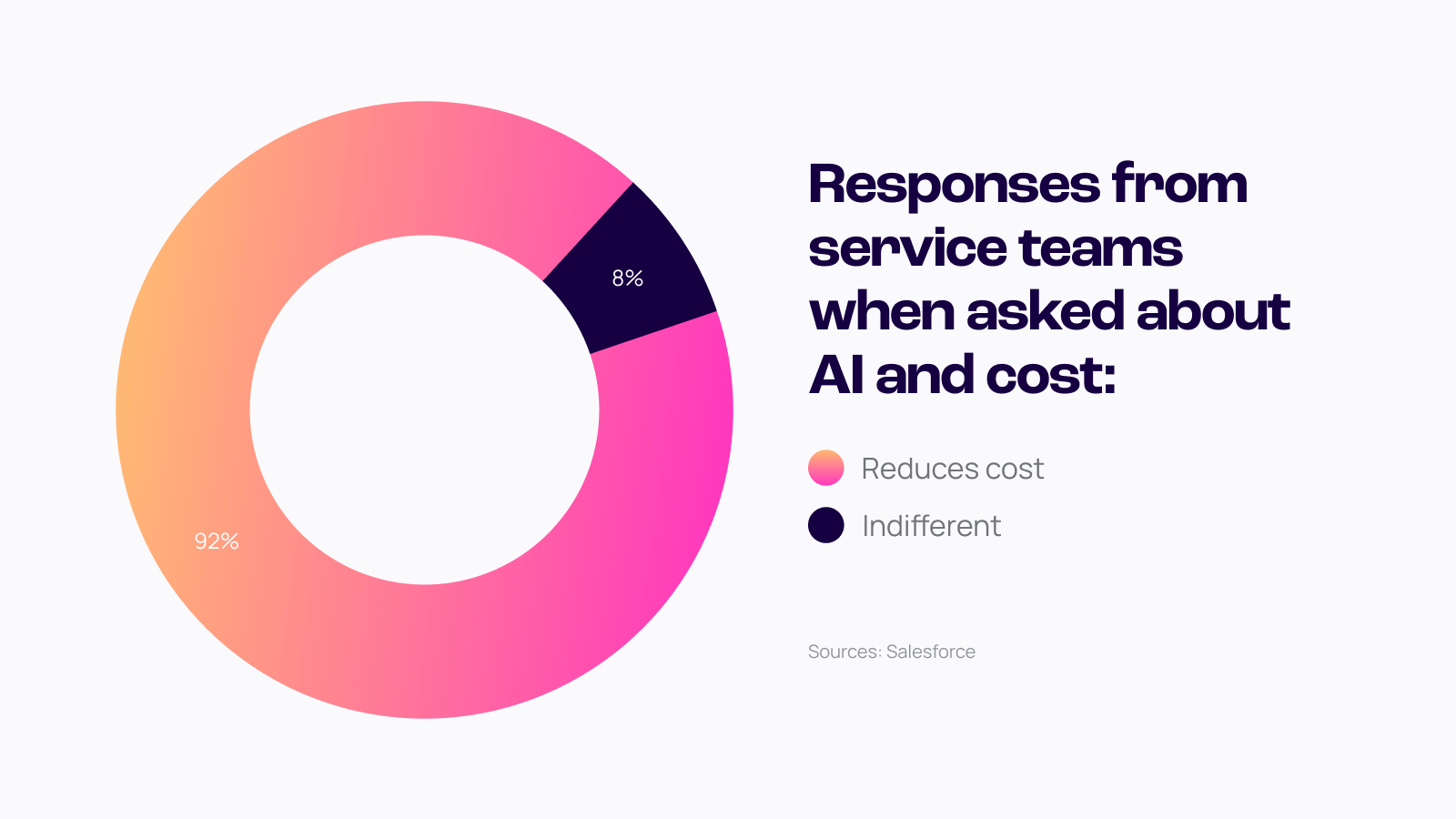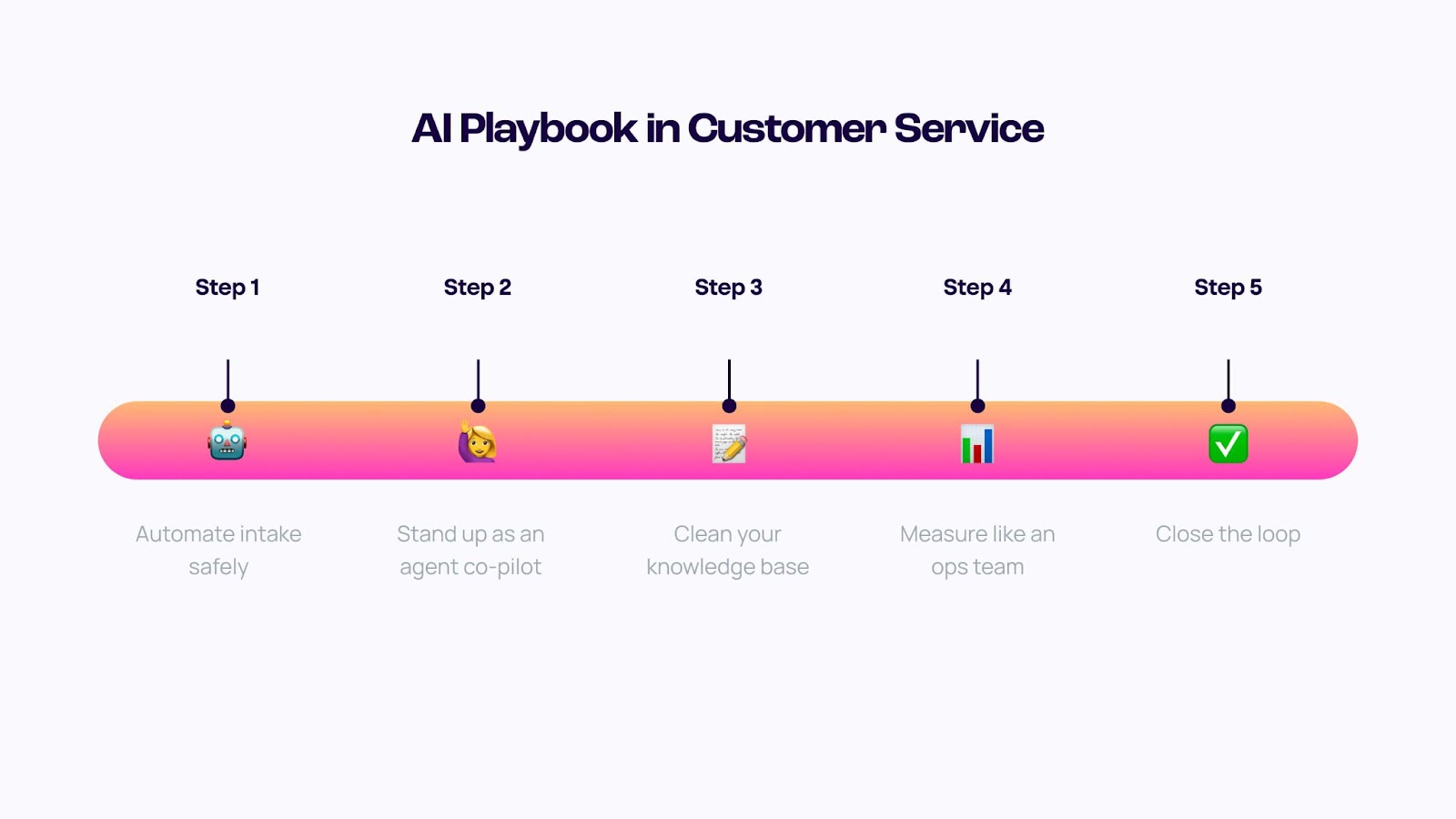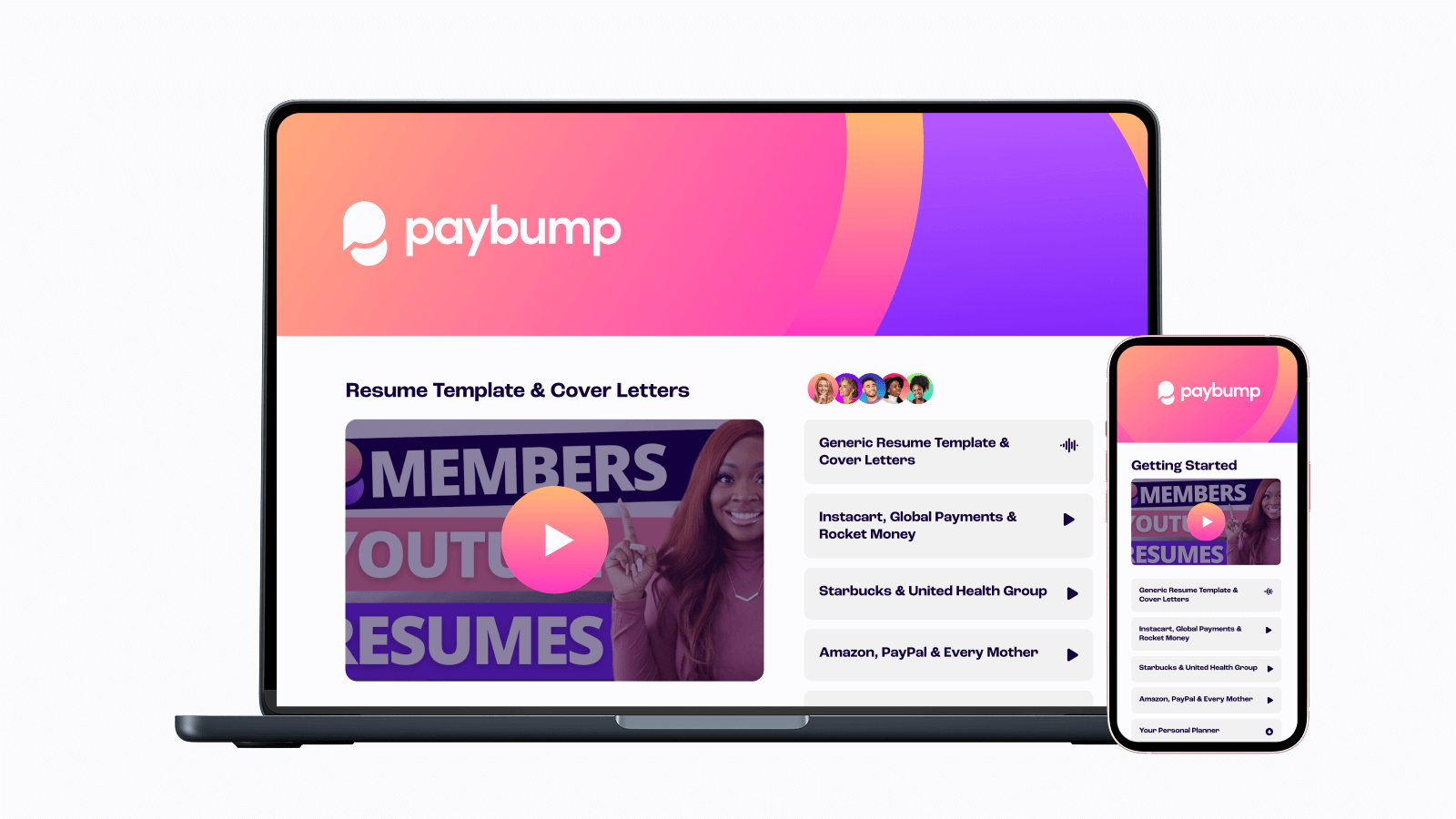
Are Customer Service Roles Dead? 💀 How to Co-Exist with AI
Customer service is having its “calculator moment.” Just like accountants didn’t disappear when spreadsheets showed up, support teams aren’t vanishing because chatbots can answer questions at 3 a.m.
What’s happening is a reshuffle.
AI is absorbing routine tickets at machine speed, while humans handle the messy, emotional, high-stakes stuff that actually builds loyalty. If you’re wondering whether AI will replace customer service, the short answer is: it will replace tasks, not the need for trust.
The people who thrive will steer the tech, not fight it—by shifting into higher-value problem solving, escalation, and customer advocacy while learning to drive the tools that are changing the job.
This guide explains how AI is used in customer service today, where it shines, where it fails, and how to future-proof your career. You’ll see real company examples, up-to-date stats, and specific steps to turn AI into your copilot (not your competitor).
How AI Is Reshaping Customer Service
Modern AI in support goes far beyond canned FAQs and generic AI powered chatbots in customer service. Current systems can triage issues, draft personalized replies in your brand voice, translate in real time, summarize history across channels, and surface the “one next best action” for an agent.
In the background, AI technology improves routing, flags churn risk, and even detects fraud patterns in returns or promotions. The most advanced teams mix chatbots, voice AI, and generative AI assistants that sit inside the help desk to coach reps, accelerate resolution and offer personalized support.
Adoption is accelerating.
McKinsey’s 2024 research notes that leaders most often see cost benefits in customer service operations from AI—evidence that the technology has clear, near-term ROI in support. Meanwhile, a widely cited study of a Fortune 500 contact center found that access to a generative AI assistant boosted agent productivity by about 14%, with the biggest gains for less-experienced reps. That’s the definition of AI-augmented human work.
We’re also seeing headline-grabbing product launches. Salesforce reports that 92% of service teams using AI say it reduces costs, and their customer surveys show growing openness to AI-assisted experiences when it’s faster and accurate.

On the front lines, Klarna’s AI assistant famously handled two-thirds of customer chats in its first month, claiming the equivalent output of 700 agents, while cutting repeat contacts and response times. Whatever you think of the marketing, that’s a stark preview of where AI in customer service automation is headed.
Benefits of AI in Customer Service
- Speed and 24/7 coverage. AI never sleeps. Properly trained agents and AI chatbots in customer service can provide instant answers, hand off to humans gracefully, and keep queues from exploding during spikes or off-hours.
- Lower costs per contact. When AI handles common, repeatable issues, the cost curve bends. McKinsey estimates that applying generative AI to customer care can lift productivity 30–45%, which is exactly why CFOs are green-lighting these projects.
- Better routing and fewer errors. Generative tools read context, sentiment, and history, then suggest classification, priority, and response language. That means fewer misrouted tickets, fewer grammar mistakes, and more consistent tone—especially useful for global teams where English isn’t everyone’s first language. Salesforce’s research also ties AI use to measurable service-team efficiencies.
- Less repetitive work for humans. The “copy, paste, apologize” routine is soul-sucking. When bots do that, people can focus on troubleshooting, goodwill gestures, and solving the root causes that drive repeat contacts.
- Higher satisfaction when used well. Used thoughtfully, AI cuts wait times and improves first-contact resolution. Early deployments, including the Klarna rollout, reported shorter conversations and fewer repeat inquiries—two metrics customers feel immediately.
The Disadvantages of AI in Customer Service (Drawbacks & Limitations)
- Struggles with emotion and nuance. AI still misses context, cultural cues, and the unspoken stuff you hear when a customer is upset. A flawless paragraph isn’t the same as feeling heard.
- Training debt. Bots need governance, guardrails, and data. If you don’t invest in brand voice, style guides, and curated knowledge, you’ll ship a polite hallucination machine. Many organizations underestimate this “content ops” lift.
- Privacy and compliance. Customer data is sensitive. You’ll need clear rules about what data flows into models, audit trails for generated content, and policies for retention and deletion—especially under GDPR/CCPA and in regulated industries.
- Brand-trust risk. Nothing angers customers like a bot that refuses to escalate or loops them in circles. Expect a backlash if you hide the “talk to a human” option. Even AI-forward companies have had to reflect on their actions when the reality didn’t match the press release.
Will AI Replace Customer Service Jobs?
The blunt part: tier-1, high-volume, highly repetitive tasks are the most exposed.
Password resets, shipping-status checks, basic returns policy questions, straightforward refunds, and scriptable troubleshooting are the first to be automated. That’s why some teams are shrinking headcount at the bottom while hiring more analysts, QA leads, conversation designers, and customer advocates who handle complex journeys.
But replacement isn’t the whole story.
The same Stanford–MIT study that found 14% productivity gains also showed that AI helps newer agents the most, compressing ramp-up time and leveling performance. Ai improves efficiency, onboarding and accelerates learning.
McKinsey’s analysts project substantial productivity upside in care but also caution that real transformation takes time—and that initial reductions in call volume have lagged the hype. Translation: jobs are changing before they’re disappearing.
Expect more AI-assisted rather than AI-replaced roles in the near term. Companies will reduce repetitive queues with integrated AI, while upskilling the humans who remain to supervise automation, handle exceptions, and close the loop with other departments.

Salesforce’s recent surveys capture the shift in mindset: service leaders report cost reduction from AI and rising customer openness—especially when speed matters—yet still prioritize human escalation paths.
The Rise of AI-Augmented Human Agents
So what does the new hybrid workflow look like?
- Smart intake. AI greets, authenticates, and collects key details, then proposes a summary, category, and priority before a human sees the ticket.
- Agent co-pilot. Inside tools like Intercom, Zendesk, or Salesforce, an assistant suggests replies, cites knowledge, translates on the fly, and flags risky language. Humans accept, edit, or reject.
- Real-time coaching. Sentiment analysis nudges reps to slow down, add empathy, or escalate. It also flags “high-value save” opportunities—credits, replacements, or proactive outreach.
- Auto-wrap. After the conversation, AI drafts the disposition, updates fields, and tags the root cause for reporting.
The upside is clear in the data. Generative assistants meaningfully raise throughput, and McKinsey links analytical AI to cost reductions in service ops across industries. For leaders, this means you can serve more customers with fewer errors without burning out the team.
Skills modern agents need to stay competitive
🫶 Empathy and de-escalation: When customers finally reach a person, the stakes are higher. Strong emotional intelligence wins.
✅ Problem framing: Turning a vague rant into a precise bug report or policy gap is a career superpower.
🛠️ Tool fluency: You don’t have to code, but you should be comfortable with prompts, macros, knowledge updates, and QA rubrics.
🙋♀️ Quality and governance: Knowing when AI is wrong—and fixing it—separates great agents from button-clickers.
✍️ Writing for a brand. AI drafts; you humanize. The best agents tune tone to the moment and the customer’s channel.
Training & platforms for AI-integrated support
Look for courses and certifications from Zendesk, Salesforce, Intercom, HubSpot, and Google on conversational design and service analytics. Pair that with short, hands-on projects—build a macro set, rewrite a help article with AI assistance, or run a post-chat QA review using a model to pre-score tickets. The artifact you create is as valuable as the certificate.
Which Companies Are Still Hiring Human Support Agents (and Why)
Some industries simply cannot automate the core of their customer interactions—at least not yet.
🏥 Healthcare and insurance: Consent, privacy, and life-or-death nuance require humans to lead. AI can prep notes and draft, but clinical and policy calls demand licensed, accountable people.
👩🏫 Education and EdTech: Parents and learners expect reassurance, not just information. Human advisors and success coaches matter.
📊 Financial services. Compliance and risk oversight increase the need for human judgment, even as bots streamline verification and routine queries.
✈️ Travel and logistics. Irregular operations—storms, strikes, cross-border issues—create complex exceptions where empowered humans save the day.
You’ll find human-first roles at large brands with premium customer experience strategies, at regulated organizations that need audit trails and empathy, and at growth-stage SaaS companies that see support as a product edge. These employers prize candidates who can blend AI-driven speed with brand-safe judgment.

Traits companies want right now
- Clear writing, even under pressure.
- Habit of documenting fixes and updating knowledge, not just closing tickets.
- Comfort supervising AI outputs and asking for escalation when something feels off.
- Curiosity about the business: the best agents spot patterns and help prevent future contacts.
How to Future-Proof Your Customer Service Career
With the future of AI in customer service looking like it’s only going to excel, as customer service representatives, its time you embraced AI to level up your own performance:
1. Upskill on AI tools—fast
Get hands-on with ChatGPT, Service Cloud’s AI features, Zendesk AI, Intercom Fin, or similar. Learn prompt patterns for: “summarize conversation,” “rewrite for empathy,” and “draft a safe denial with policy links.” Salesforce and others publish adoption data showing that service teams actually see cost reductions with AI—you want to be the person who can realize those gains responsibly. Salesforce
2. Lead with empathy and problem-solving
Your edge is human: reading tone, repairing trust, negotiating fair outcomes, and coordinating with product or ops to fix root causes.
3. Learn to monitor and correct AI
Treat the model like a strong but error-prone intern. Spot hallucinations, check for policy compliance, and leave the ticket better documented than you found it.
4. Earn relevant certs.
Free or low-cost options from Coursera, HubSpot Academy, Zendesk, and Salesforce signal momentum and open doors—especially when paired with a portfolio of artifacts (macros, knowledge articles, QA rubrics).
5. Quantify your impact
Track CSAT, FCR, AHT, save rates, and deflection. If AI helps you cut handle time by 20% without hurting satisfaction, that’s a promotion-worthy story.
6. Build cross-functional instincts
Great support pros are translators between customers and the business. Join bug triage, run a weekly “voice of the customer” digest, and make sure someone in the product actually reads it.
The Future of Customer Service 🔮
The classic “agent as responder” job is giving way to agent as strategist. You’ll still answer customers, but you’ll also shape policy, maintain the knowledge layer, and supervise automation.
Expect three big shifts:
- Co-pilots everywhere. Nearly all ticketing and CRM platforms are integrating generative features that draft, summarize, and route. Service teams using AI report rising efficiencies and, in many cases, lower costs—a trend Salesforce’s research highlights across industries. Salesforce
- More asynchronous, cross-functional work. Support will look more like operations: analyzing cohorts of tickets, fixing processes, and closing loops with the teams that own the root cause.
- AI agents that actually handle value—not just FAQs. Gartner and others predict bots becoming a primary channel for a meaningful slice of companies in the next few years, while McKinsey forecasts major productivity gains. Whether your brand leans voice, chat, or app-embedded support, the human job shifts toward coaching the system and jumping in when stakes or complexity spike. McKinsey & Company
A balanced view:
Not every press release survives contact with reality. Some early adopters have had to backfill human roles, refine knowledge, or throttle their bots after launch.
That doesn’t mean AI is a fad; it means governed adoption matters.
The winners will pair hard-nosed measurement with clear escalation paths and transparent messaging to customers. Customer Experience Dive
Practical Playbook: How to Use AI in Customer Service Today

Step 1: Automate intake safely
Let AI greet, authenticate, and collect structured details (order ID, device, steps tried). Always offer “talk to a person” and capture consent for data use.
Step 2: Stand up as an agent co-pilot
Start with low-risk suggestions: summaries, tone rewrites, policy inserts with citations. Require human review until your QA scores clear agreed thresholds.
Step 3: Clean your knowledge base
Archive stale articles, add disclaimers where policy is changing, and adopt a mini style guide. AI is only as good as the content it’s trained on.
Step 4: Measure like an ops team
Track deflection and the downstream effects (repeat contacts, CSAT, save rate). The Stanford–MIT study found the biggest gains for newer reps; use that insight to narrow your training focus.
Step 5: Close the loop
If AI reveals a fixable root cause—say, a confusing returns page—partner with product or marketing to remove the trigger. Document the change and watch the metric.
Example Use Cases (You Can Pilot in 30 Days)
- Personalized reply drafts. Feed conversation history and policy to generate a first draft, then edit for tone. Perfect for personalized experiences at speed.
- Multi-language support. Translate inbound and outbound messages in-line, with a human sanity check. Perfect for meeting customer preferences in communication.
- Proactive saves. Use propensity models to flag “at-risk” customers mid-conversation and give agents discretion to offer credits or replacements.
- Refund guardrails. Let AI suggest tighter verification on high-risk patterns (e.g., serial “item not received”), but keep the final call human.
- Agent coaching. Auto-score a subset of transcripts daily and queue items for human QA—raising quality without adding headcount.
Two Narratives: Optimists vs. Skeptics
🌝 The optimist’s take
AI is the first practical way to scale great service without scaling headcount linearly. Assistants draft better emails than many humans on a bad day; bots can speak dozens of languages; analytics spot churn risks before they explode.
Leaders report cost reduction, and customers are increasingly open to AI for speed—provided humans remain close at hand.
🌚 The skeptic’s take
Real life is messier than a demo. Models hallucinate, data is fragmented, and a tone-deaf bot can damage brand trust. McKinsey’s 2024 customer-care research says the early impact on call volumes has been slower than expected; even bold adopters have re-staffed sensitive queues. Transformation is coming, just not overnight.
🌗 The middle path
The durable move is human-in-the-loop: AI does the lifting; people keep responsibility. That requires clean knowledge, real QA, and clear escalation rules. When customers know a person is two clicks away, satisfaction climbs.
AI Use Cases in Customer Service (Beyond the Hype)
Examples of AI in customer service are stacking up. Today, thousands of companies are implementing AI across all walks of customer interactions.
Here are some key AI in customer service examples:
🇫🇷 Multilingual support: Translate messages in-line so agents write naturally and platforms handle the rest.
✅ Policy-safe refunds: Suggested replies insert the right clauses and offer compliant gestures without over-refunding.
🚨 Fraud pattern detection: Models flag serial “item not received” claims and nudge agents to verify before refunding.
💬 Tone coaching: If sentiment dips, assistants recommend calmer phrasing to de-escalate.
How to Integrate AI Agents in Customer Service
For all the Managers out there reading this, here’s your 4-week action plan to embedding AI in your customer service team:
- Day 1–2: Define success. Choose two metrics (for example, first-contact resolution and repeat-contact rate).
- Day 3–4: Audit knowledge. Delete stale macros, add screenshots, and standardize policy links.
- Day 5: Pilot one co-pilot feature (summaries or tone rewrites) with mandatory human review.
- Week 2: Expand to low-risk queues and set a red-button escalation.
- Week 3: Review QA data. Keep what improved outcomes; suspend anything that drifted.
- Week 4: Share results in a short internal memo—wins, misses, and next experiments.
Who’s hiring right now? Hiring cycles change, but you’ll consistently find headcount at major health insurers, hospital systems, universities, fintechs, and travel brands promising recovery during disruptions. Growth-stage SaaS companies with complex onboarding also keep human support teams because context matters. Scan curated boards weekly, set alerts for “remote” and “customer service experience,” and prioritize postings that publish pay ranges and training details so you know the ramp and expectations up front.
Get Hired Faster—With AI-Proof Skills
Want leads for customer service roles at companies that still invest in people?
Access Paybump’s job board and customer service resume templates designed for AI-integrated teams. We’ll help you highlight outcomes (“reduced repeat contacts by 22%”), showcase AI-assisted workflows (drafted replies, deflection, QA), and pitch yourself as the agent every manager wants in 2025 🔥

Stay ahead of the curve. Subscribe to the Paybump newsletter for AI-proof career advice, remote job alerts, and tools to future-proof your work life.
FAQs
Will AI replace customer service agents?
Artificial Intelligence (AI) will replace some tasks like analyzing customer data and entry-level functions, but human intervention is still essential for complex or emotional issues.
What are the benefits of using AI in customer service?
Faster responses, 24/7 coverage, lower costs, better routing, and less repetitive work for agents. Service leaders report cost reductions, and customers show growing willingness to use AI when it’s faster.
What are the disadvantages of AI in customer support roles?
Weakness with emotion and nuance, training debt, privacy/compliance risks, and brand trust hits when bots block escalation. Some high-profile launches needed human re-investment.
How can customer service workers adapt to AI?
By learning to use AI tools, improving communication skills, and focusing on tasks AI can’t yet do well.
Which companies still hire human support agents?
Companies like Amazon, Amex, and startups in healthcare, fintech, and education are still hiring—and increasingly seeking tech-savvy agents.
Will customer service be replaced by AI?
Routine tasks will be, yes. But companies still need humans for complex judgment, edge cases, and relationship repair. Evidence points to task automation plus human upskilling, not mass obsolescence.
Do AI agents really “replace 100 people”?
Ignore the slogan; measure outcomes. Klarna’s launch claimed the equivalent work of 700 reps with shorter handle times—but your mileage will vary based on data quality, knowledge, and governance. PR Newswire
What skills should I learn now to leverage AI in customer service?
Empathy, structured writing, problem framing, and AI-tool fluency. Add a platform certification and a portfolio of macros/KB updates/QA rubrics.






